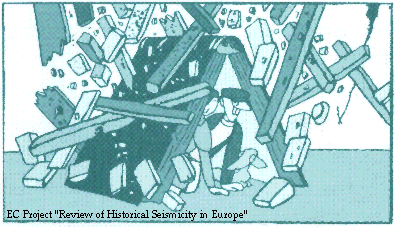
EC project "Review of Historical Seismicity
in Europe" (RHISE) 1989-1993

|
[Deliverables and queries] [Presentation] [Homepage] |
Introduction
The study of the earthquakes which occurred
at border regions was the subject of the CEC project RHISE. In this context,
the Eastern Alps area is interesting for the presence of different nations
and rulers through history.
In the time window 1670-1700 high seismic activity
was observed in the Italian territory, including some notable earthquakes
in the Eastern Alps. In addition, the study of the seismicity of this time
window is particularly stimulating because of the earthquake of December
4, 1690 located in the Villach area. As no strong events are reported after
1700 in this area (Fig. 1), the 1690 earthquake may offer interesting suggestions
also for understanding the 1348 earthquake, usually located in the same area
(Hammerl, 1994).
The 1690 earthquake is better known
in the Austrian territory, where it caused damage (Eisinger, 1991), but it
seems to have left no traces in northern Friuli (Slejko and Cergol, 1991),
about 50 km from the epicentral area.
The lack of information on the effects of the
1690 earthquake on the Italian territory is not yet adequately explained
and remains a crucial point for a global comprehension of the event. In order
to better understand the possible causes of these circumstances, this study
examines the information coming from the sources of the main seismological
compilations and some archival sources for the events of the time window
1689-1700, which could have affected the Friuli area. One of the problems
is to understand if the lack of sources for this area applies only to the
1690 earthquake or if it is common for all events of that period.
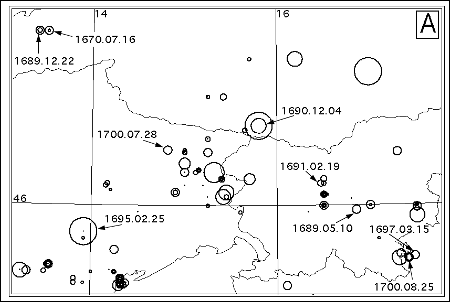
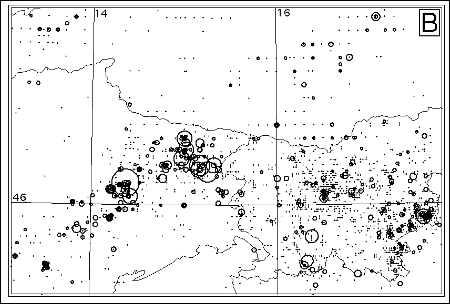
Data from the sources of the seismological
compilations
Italian sources for the 1690 earthquake
The main Italian records of the 1690 earthquake
come from Bonito's compilation (1691) (Fig. 2). Bonito quotes the Avvisi
di Venezia of December 9 and 16, 1690, and the Avvisi di Vienna
of December 10. The Avvisi were collections of news coming from various
Italian and European towns, handwritten or, more rarely, printed and distributed
in the most important economic and cultural centres. The three above quoted
Avvisi are all published in Naples, respectively on December 20 and
27 (Venice) and on January 3, 1691 (Vienna).
The first quoted Avvisi di Venezia (1690a)
reports an earthquake on the S. Barbara's day (December 4), felt at 23.00,
followed by a lighter one at 3.00 ; it caused some chimneys to fall and light
damage to the church of SS. Giovanni and Paolo and to other churches in Venice.
The Avvisi di Venezia dated December 16 (1690b) says that the most
serious damage was in Villach, where some buildings collapsed, and in the
Venetian Parenzo and Rovigno, where 20 casualties were counted. It is remarkable
that Bonito, the only author using this source, is also the only one to report
damage and victims in Istria.
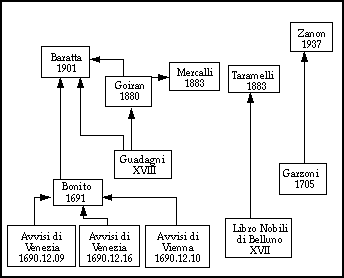

The Avvisi di Vienna (1691) of December
10 reports that "una terribile scossa di Terremoto" was felt in the
city and nearby, frightening all the inhabitants (Fig. 3). Other versions
of Avvisi, found during the research for retrieving the original Bonito's
sources (Tab. 1) are: an Avvisi di Venezia of December 9 (1690c) and
an Avvisi di Vienna of December 10 (1690), published in Foligno on
December 15 and 19 respectively. These versions of Avvisi report different
information from that used by Bonito: in Venice some chimneys fell and the
shock was felt on the nearby islands too, without damage; in Vienna the
earthquake was felt on Monday evening, without damage. The shock was felt
also in Graz, a locality not quoted by the other Avvisi (Tab. 1).
Only poor information comes from other Italian
sources: Garzoni (1705), quoted by Zanon (1937), confirms that a shock was
felt in Venice in 1690, while captain Mocenigo was embarking for the war
against the Turkish pirates; a manuscript of Guadagni (XVIII), quoted by
Goiran (1880) and Baratta (1901), reports a shock felt in Verona on December
4, 1690 "circa le due di notte". Taramelli (1883) refers to Belluno
reporting a "gran terremoto" without damage which occurred on May
4, 1690; he quotes the "Libro delle provvigioni" (XVII) of the noblemen
of the city. The Italian catalogue (Postpischl, 1985) does not mention any
earthquake in northeastern Italy in May 1689, 1690 or 1691. A direct check
of the source of Taramelli has given no more information on the date of the
earthquake, because the register was seriously damaged by a flood and it
is illegible.
Information on the 1690 earthquake coming from
German and Austrian sources are analysed in the study by U. Eisinger and
R. Gutdeutsch (1994).
Earthquakes in 1689, 1691 and 1695
A brief analysis of the information contained
in the main seismological compilations was performed for some other events
which occurred in the Eastern Alps at the end of the 17th century.
For the December 22, 1689 earthquake at Innsbruck
the principal sources are the Avvisi di Innsbruck (1689), quoted by
Bonito, and a few local chronicles
|
Avvisi di Venezia |
Avvisi di Venezia |
Avvisi di Venezia |
Avvisi di Vienna 10 dicembre |
Avvisi di Vienna 10 dicembre |
|
|
|
Lunedì (4 dicembre) verso le 23 hore
fu in questa città e isole vicine sentito un buon scosso di terremoto
e qui non ha cagionato maggior male della caduta di qualche camino, nè
da altre parti si ha fin ad hora alcuna notizia di male
|
Lunedì festa di S. Barbara verso le
23 hore seguì in questa Città una scossa di Terremoto che fece
dar sul Campanile di S. Marco à botti alla Campana ... ma senza altro
danno che della cascata di alcuni camini; è allentata la Chiesa dei
SS. Gio. e Paolo; e qualch'altra; e verso le 3 hore si fece di nuovo sentire;
ma più leggiermente |
Nello stesso giorno che si sentì qui
[il] Terremoto è capitato avviso che si sia fatto sentir molto fiero
a Villach ... sì come a Parenzo, Rovigno & altri luoghi dell'Istria
... nel primo dicesi habbi rovinati edifici e fatti altri considerabili danni
e nel secondo habbi fatto cader qualche Casa con morte di circa 20 persone
|
||
|
|
Lunedì verso la sera fu sentito qui
un gran scosso di terremoto che se avesse più durato ... sarebbe successo
del male. Anco da Gratz scrivono averlo sentito
|
Alli 4 si senti quì ... una terribile
scorsa di Terremoto come pure nelle provincie vicine; il che essendo insolito
in questi paesi; apportò gran spavento
|
quoted by Schorn (1902). These sources describe
the effects at Innsbruck and its immediate neighbourhood only, but there
is no information for Friuli or the Veneto area.
The Ljubljana earthquake of February 19, 1691
is mentioned by local and coeval sources (Thalnitscher, 1691) and by important
collections of the 17th and 18th centuries, such as Theatrum Europaeum (1699)
and Collection Académique (Gueneau de Montbeillard, 1761). The only
record for the Italian territory comes from Venice. The quake is however
reported, although a little confusedly, to have been felt over a wider area,
as far as Basel and the Rhine Valley (Seyfart, 1756; M.J.A.W., 1764).
The lack of information from Friuli is evident
for the Asolo earthquake of February 25, 1695, which caused heavy damage
in the Republic of Venice. The quake is recorded by many coeval chronicles
of northern Italian towns and by Collection Académique. The earthquake
caused many victims in the Veneto region, was heavily felt in Emilia and
Lombardia (Baratta, 1901) and recorded, according to Schorn (1902) and Ambraseys
(1976), in Bolzano and Switzerland; no sources mention the Friuli area.
The July 28, 1700 Raveo earthquake
On July 28, 1700 a strong earthquake hit northern
Friuli damaging some villages in the Degano Valley. This earthquake is almost
unknown because it took place in a mountain area of modest demographic
consistence and slender economic means. The poverty caused also cultural
isolation and little news from this region reached the major towns.
In Tommasi (1888) and Baratta (1901) this quake
is briefly described; their sources (Fig. 4) refer only to Enemonzo (APEn,
1700a) and S. Stefano di Piano (APPArt, 1700): "Al 28 luglio furono sentite
fortissime scosse ad Enemonzo e a S. Stefano in Piano; a Enemonzo ruinarono
delle case, si screpolarono i muri della chiesa e perirono 6
persone".
Ambraseys (1976) gives a more detailed report
of the event, listing eleven localities: "Locally destructive shock which
affected Enemonzo, where the church and its belfry were ruined and six people
were killed. Raveo, Esemon, Quinis, Priuso and Mediis were also ruined. At
Socchieve many houses collapsed. Damage extended to the settlements of S.
Stefano di Piano, Muina, Ovaro, Mione and along the river Degano. The shock
caused a landslide from Mt. Forchianon. There is no evidence that the shock
was felt elsewhere".
The family-tree of the sources for the study
of the Raveo earthquake includes also a study by Gentile et al. (1984). This
paper will be analysed in a subsequent paragraph.
Comments
- For the 1689, 1690, 1691 and 1695 earthquakes
the basis of the sources used by the seismological compilations is very similar:
local descriptions for the
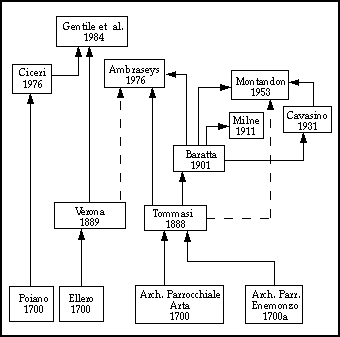
most damaged localities, and publications of
wider diffusion (collections, Academy Acts) giving information on large towns,
even located far from the damaged area. For these events no information for
towns or villages in Friuli has been retrieved, even for the 1695 Asolo
earthquake, which occurred in Veneto, where communications were easier than
in Friuli.
- On the contrary, for the 1700 earthquake,
only local and prevalently ecclesiastical sources have been retrieved: they
refer only to the mountain area of Friuli and ignore closer important towns
like Udine or Venice and the nearby territories of the Austrian monarchy.
As this information basis is quite unsatisfactory, mostly for Friuli, further investigations of archival sources were undertaken, with particular attention to the ecclesiastic ones, from which a few references to Friuli derive.
Civil sources
At the end of the 17th century, the northeastern
Alpine area included some territories belonging to the Republic of Venice
(Veneto, part of present Friuli, and part of Istria and Dalmatia) and some
territories under the Austrian Monarchy: Tyrol (Innsbruck and Bolzano),
Principality of Trento, Carinthia (Villach, Klagenfurt, part of the present
province of Udine), Krain (with Ljubljana, Gorizia and Trieste), Styria and
Croatia.
Since 1420 Friuli had been a province of the
Republic of Venice, named Patria del Friuli. Its territory was divided into
Quartieri della contadinanza to which the village communities referred.
The Friuli mountain area (the most affected by seismic events) consisted
of two administrative systems: in eastern Friuli there was the Carnia province,
and in western Friuli a network of feudal possessions. In the 18th century,
that which is now Carnia was mostly ruled by the Comunità di
Villaggio (village communities) and included (Fig. 8): the Quartieri
of Carnia (Socchieve; S. Pietro; Gorto, divided into Pieve of S. Maria and
S. Giorgio); the Ville of Carnia annexed to the Tolmezzo community
(Sappada and Forni Avoltri; Sauris; Timau and Cleulis; Alesso and Oncedis);
Moggio Abbey and its territory; Forni Savorgnani; the Cadore.
Civil archival sources were analysed in previous
studies (Cergol and Slejko, 1991). From that kind of sources only one piece
of information regarding the 1690 Villach earthquake was found in the Archive
of the Republic of Venice: light damage to the fortress of Chiusa is reported
in a letter from the fortress keeper to the "luogotenente in Udine" (Slejko
and Cergol, 1991). Further information on the investigation in the State
Archives of Venice is found in Albini (1993). No more information for the
1690 and 1700 earthquakes was found in the Archivio di Stato of Udine or
in those municipal archives of Friuli which store documents of the 17th and
18th centuries (Cergol, 1991).
Ecclesiastic sources
Recently a new research was undertaken in the
Archivio Arcivescovile of Udine, which stores funds concerning Friuli and
Carinthia, and in the parish archives of the main villages in northern
Friuli.
At the end of 17th century, the territory of
Patria del Friuli, from the ecclesiastic point of view, belonged to the
Patriarchate of Aquileia (which included the Aquileia diocese and many suffragan
dioceses, among which Concordia and Ceneda, in Friuli; Fig. 5), which extended
beyond the borders of the Republic of Venice and also included some territories
under the Austrian monarchy. The northern diocese border was marked by the
Drau river, north of the Julian Alps; part of Styria, all Krain, Istria and
the northern Dalmatian coast belonged to the Patriarchate. The Patriarch
Curia had been seated in Udine since 1447.
The archdeacons, as representative of the Patriarch,
took care of the farthest territories of the Diocese, because of its large
extent. Four Archdeaconships,
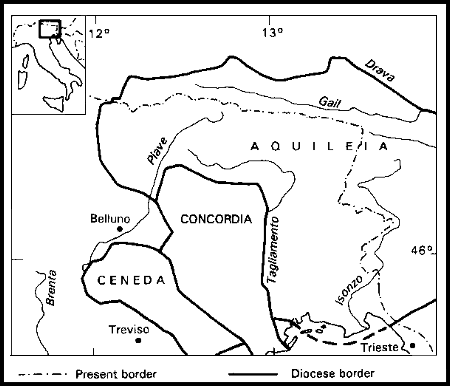
one in Villach for Carinthia and three in Krain,
had been established for the trans-Alpine regions. The Habsburg monarchy
strongly opposed the patriarchal jurisdiction over the Austrian territories,
especially after the Reformation; because of this reason, the communications
between the Patriarch and the archdeacons were often difficult (Paschini,
1933).
Pastoral visitations
Documents about four pastoral visitations during
the decade following the earthquake of 1690 (Cergol, 1991) are kept in the
archive of the archbishop curia in Udine; pastoral visitations were made
periodically by the titular bishop or by his representative, in order to
check the state of his diocese.
In the first pastoral visit, the bishop of
Cittanova, commissioned by the patriarch of Aquileia, visited churches and
monasteries in the Cividale area from July 21 to 25 1692 (ACArUd, 1692a);
in the second, the same bishop visited churches in the Aquileia diocese from
August 17 to 31 of the same year (ACArUd, 1692b). These two visitations involved
a limited area far from the epicentral area of the 1690 earthquake, and neither
information on the Villach quake nor on other seismic events is reported
.
Filippo Giacomo Reischl, archdeacon of northern
Carinthia, made a pastoral visitation in this region, probably between June
1694 and January 1696, when he sent his report to the Aquileia Patriarch
Giovanni Delfino. The report (ACArUd, 1694-95) is stored in the file A
parte imperii, which contains documents referring to Austrian territories
under the ecclesiastic jurisdiction of the Aquileia Patriarchy. This report
does not give the exact timing of the visitations but refers in the title
to the years 1694 and 1695 and reports that the Villach town was visited
on June 16, 1695. The stops of the visitation along the Gail Valley, the
northern Drau Valley, the Villach neighbourhood and some villages around
Tarvisio, are described accurately (Fig. 6).
A fixed scheme was used by the visitor in his
report for each parish: the church name, a list of secondary churches, the
general state of the building, the name of the parson and collaborators,
a judgement on the parson's management, the parish income and the number
of parishioners.
More than 30 parishes, in addition to secondary
churches, were examined during this pastoral visitation and the only information
on damage caused by the earthquake refers to Villach. The S. Giacomo parish
church was completely destroyed; according to the visitor it was promptly
reconstructed and was, at the visitation time, the most beautiful of all
Carinthia. It should be noted that the date of the quake is reported as
"quarto septembris in festo S. Barbarae", but the holiday of S. Barbara
is on December 4. The bell tower, which collapsed because of the quake was
not yet completely rebuilt but the bells and the new clock were already
installed. The S. Michele chapel, located in the cemetery, near the parish
church, was still damaged and it was not possible to celebrate the service
inside. The Santo Spirito church, near the hospital, was already completely
restored.
No further description of damage is reported
for the other inspected parishes. More precisely a tower (or bell tower)
"ex magna parte ruinata" of the Firniz church (today Fürnitz,
a few kilometres from Villach) is mentioned in the report, but there is no
direct reference to the earthquake. It should be noted, however, that the
archdeacon Reischl was the Villach parson and that he could have been motivated
to amplify the damage to his church; on the contrary his companion, Martin
Reschen, was the parson of St. Stephan in Carinthia but he does not refer
to any damage to his own parish.
Information on many parishes may be lacking
because of the religious wars still continuing in those years; in some cases
the visitor himself stated the impossibility of obtaining a clear view of
the situation: because of the great misery, the inhabitants of Tarvisio valley
(parishes of Malborghetto, Cuniza, Camporosso), rebelled against both the
civil and religious authorities.
The Patriarch Delfino personally visited Carnia,
one year after the quake of July 28, 1700, between June and August 1701.
The bishop's journey is reconstructed in Fig. 7. Although the Patriarch inspected
localities included in the area hit, a description of damage is available
only for a few churches. The document (ACArUd, 1701a) consists mainly of
orders for repairing outer walls, arches and floors of the churches of S.
Nicolò di Alzeri (Piano d'Arta), S. Nicolò di Ligosullo, Spirito
Santo di Monaio, S. Vito e Modesto di Liariis, S. Volfango di Pracerei (not
yet identified) and S. Giacomo di Forni di Sopra.
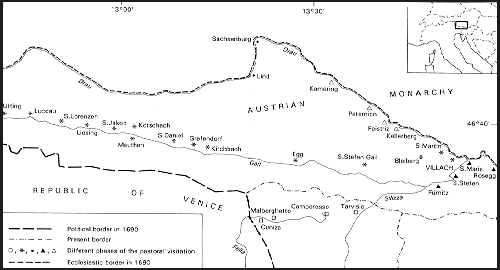
This information is important because it refers
to localities not reported by sources already known.
Indirect information about the 1700 earthquake
comes also from the series Documenti of the same fund (ACArUd, 1701b).
For the Ovaro locality there is a letter from the parish to the Patriarch;
the priest writes that he was not able to fulfil his orders given during
the last pastoral visitation because his church was damaged by an earthquake.
The church of Valtois (Ampezzo) in 1701 still
remained ruined by an earthquake and was not rebuilt, but the information
is not directly connected with the 1700 shock.
Sources from the parish archives
Research in Friuli has been carried out in some
parish archives, which hold documents of the end of the 17th and 18th centuries,
namely Tolmezzo, S. Floriano di Illegio, Enemonzo, Alzeri, Piano d'Arta,
Paularo, Pontebba, Resia, Dogna, Chiusaforte and Zuglio. Other archives,
which hold documents that could be of interest, were temporarily closed at
the time of the research.
There is no information about earthquakes between
1690 and 1695; on the contrary, data are available for the 1348 and 1511
earthquakes and for the 1692 flood.
The investigation on the 1700 Raveo earthquake
was more fruitful. Tommasi (1888), Verona (1889) and Ciceri (1976) used sources
from the parish archives: Verona from the parish archives of Lauco and Maiaso
and a note written by G. Ellero (1700) in the Registro dei Battesimi e
dei Matrimoni of Lauco; Ciceri reports a note by F. Poiano (1700) of
Maiaso. Gentile et al. (1984) refer to the sources published by the above
mentioned authors (Fig. 4).
Information about the earthquake has been found
in the Enemonzo parish archive, both in the Registro dei morti (APEn,
1700a), quoted by Tommasi (1888), and in the Registro dei nati (APEn,
1700b) which was not considered before. The note of Poiano is transcribed
in a recent chronicle of Enemonzo (APEn, n.d.); this record is almost the
same as that reported in Ciceri and is probably the one used by Ambraseys
(1976). The register of Camerari di S. Stefano in Piano, source of Tommasi
(1888), has been found at the parish archive of Piano d'Arta and gives the
cost of repairs to the church belfry, damaged by the earthquake. The bell
tower of Alzeri, according to the documents of its parish archive, was damaged
too.
From all these sources it is possible to draw
a more precise outline of the Raveo earthquake. The earthquake happened "one
hour before day, it lasted half an hour and felled all the tiled houses"
(many houses had wooden or straw roofs) (APEn, 1700a). The village most affected
seems to have been Raveo with 5 victims (APEn, 1700a). In this area the villages
consisted of a few houses and the damage refers, principally, to the churches,
the only relevant buildings at that time.
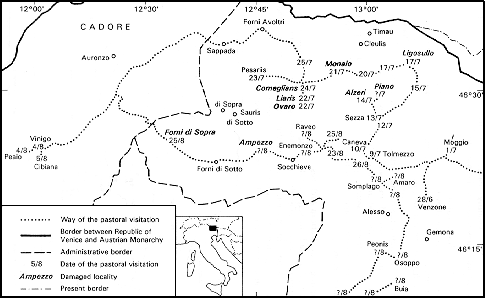
The damage was certainly heavy, but a careful
reading of descriptions shows that only a few houses and some churches collapsed.
In Tab. 2 the historical information is summarised
and in Fig. 8 the damaged localities are shown. The total number of victims
was 18. The distribution of information shows that the earthquake affected
mostly the Quartiere di Socchieve and the Quartiere di Gorto,
both located in the Degano Valley. The only information about other
Quartieri concerns Piano and Imponzo. The knowledge of this earthquake
is still limited to the Degano valley, the most damaged area, and little
is known about its surroundings. In addition, most of the information on
the 1700 earthquake, also taking into account the data from the sources quoted
by the seismological compilations, derives from ecclesiastic sources, such
as official visits, administrative papers and parish records.
Sampling in the Vatican Archives
A sampling made in some funds of the Vatican
Archives did not give appreciable results for the earthquakes of the Eastern
Alps in the time span 1690-95. The only information comes from the fund
Segreteria di Stato, where the Avvisi quoted above were found.
Further information about the investigation in the Vatican Archives is found
in Castelli (1993).
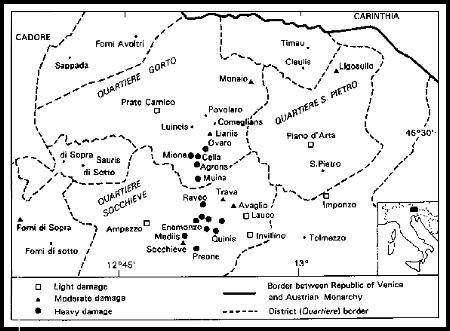
|
District |
Locality |
|
victims | ||||
|
1700a |
1700 |
1700 |
1700 |
1701a |
|||
| S. Pietro |
Piano d'Arta: S.Stefano*
S.Nicolò d'Alzeri* |
LD |
LD |
||||
| Socchieve |
Ligosullo: S. Nicolò* |
LD |
|||||
| Enemonzo |
HD |
|
|
||||
| Colza |
HD |
||||||
| Maiaso |
HD |
||||||
| Fresis |
HD |
|
|
||||
| Quinis |
HD |
||||||
| Raveo |
HD |
|
|
|
|||
| Esemon di Sotto |
HD |
||||||
| Socchieve |
MD |
|
|
||||
| Mediis |
HD |
|
|
||||
| Preone |
HD |
HD |
|||||
|
Ampezzo
Valtois |
LD |
HD? |
|||||
| Invillino |
LD |
||||||
| Avaglio |
MD |
||||||
| Trava |
MD |
||||||
| Lauco |
LD |
||||||
| Gorto |
Liariis: S. Vito e
S. Modesto* |
MD |
|
||||
| Ovaro |
HD |
|
|
|
|
||
| Mione |
HD |
|
|
|
|||
| Muina |
HD |
|
|
|
|||
| Agrons |
HD |
|
|||||
| Cella |
HD |
||||||
|
Monaio: Spirito Santo* |
MD |
||||||
|
Comeglians: S. Nicolò* |
HD |
||||||
| Tolmezzo |
Pracerei: (?)
S. Volfango* |
LD |
|||||
|
Imponzo: S.Floriano* |
LD |
||||||
|
Forni Savorgnani |
Forni di Sopra: S.Giacomo* |
D |
|||||
|
* Damage refers to the church only |
|||||||
Comments
Information from Italian sources on the December
4, 1690 earthquake are confirmed to be very poor for Friuli. Ecclesiastical
and civil documentary sources do not give any new information on this area,
with the exception of the letters from the State Archives of Venice. The
report of the pastoral visitation (ACArUd, 1694-95) confirms heavy damage
in Villach describing the restoration of S. Giacomo church (rebuilt in a
very short time), and of the belfry and cracks in the chapel of the cemetery,
but no evidence of damage in any other church near Villach or in northern
Carinthia is reported, as well as for the present Italian territory. This
lack of information could suggest that the 1690 Villach earthquake actually
did not caused any damage in Friuli and, for this reason, is not mentioned
by local sources.
The 1689 Innsbruck, the 1691 Ljubljana, and
the 1695 Asolo earthquakes are not recorded by documents pertaining to Friuli.
However, in the administrative and ecclesiastic archives of this region many
documents have been found for other earthquakes, even for some not included
in the Italian catalogue (Postpischl, 1985). Archival sources are particularly
rich for other natural events such as floods (1692 at Piano d'Arta, Cercivento,
Forni and Timau), landslides, snowfalls etc. This shows that these earthquakes
were probably local and they did not cause notable damage in Friuli.
On the other hand, no source out of Carnia mentions
the 1700 Raveo earthquake, which likely hardly hit the life and poor economy
of this area. This quake was probably very shallow as many other events in
this region; they hit a limited area and are not felt even a few kilometres
from the epicentral area (Gentile et al. 1984; Barbano, 1991). The lack of
good roads connecting to foreign countries and to other Venetian territories,
and the cultural isolation of Carnia did not help transmission of
information.
Acknowledgements
This paper is partly based on some investigations
performed by Tullia Catalan and Marina Cergol.
The authors wish to thank Massimiliano Stucchi
for his stimulating contribution.
References
ACArUd (Archivio della Curia Arcivescovile
di Udine), 1692a. Visite pastorali, Cronistoria, Vol. GI, fasc. 40, pp.
168-183.
ACArUd, 1692b. Visite pastorali, Cronistoria,
Vol. GI, fasc. 40, pp. 184-300.
ACArUd, 1694-95. 'A parte Imperii', Visite
pastorali, Relatio visitationis facta per P. J. Reischl, Archidiac. per
Superiorem Carinthiam.
ACArUd, 1701a. Visite pastorali, Cronistoria,
Vol. GI, fasc. 42, pp. 301-401.
ACArUd, 1701b. Visite pastorali, Documenti,
Vol. 8, fasc. 74-81; Vol. 10, fasc. 93-102.
Albini, P., 1993. Investigation of 17th and
18th centuries earthquakes in the documents of governors and representatives
of the Republic of Venice. In: M. Stucchi (Editor), Materials of the CEC
project Review of Historical Seismicity in Europe, Milano, 1, pp.
55-74.
Ambraseys, N.N., 1976. The Gemona di Friuli
earthquake of 6 May 1976. In: P. Pichard, N.N. Ambraseys, G.N. Ziogas, 1976.
The Gemona di Friuli earthquake of 6 may 1976. UNESCO, Restricted Technical
report RP/1976-76, Paris, II, pp. 1-111.
APEn (Archivio Parrocchiale di Enemonzo),
n.d. Libro storico di Enemonzo. ms.
APEn, 1700a. Libro dei morti.
APEn, 1700b. Libro dei nati.
APPArt (Archivio Parrocchiale di Piano d'Arta),
1700. Registro dei Camerari di S. Stefano in Piano.
Avvisi di Innsbruck, 1689. 26 dicembre.
Napoli.
Avvisi di Venezia, 1690a. 20 dicembre.
Napoli.
Avvisi di Venezia, 1690b. 27 dicembre.
Napoli.
Avvisi di Venezia, 1690c. 15 dicembre.
Foligno.
Avvisi di Vienna, 1690. 19 dicembre.
Foligno.
Avvisi di Vienna, 1691. 3 gennaio.
Napoli.
Baratta, M., 1901. I Terremoti d'Italia.
Saggio di Storia, Geografia e Bibliografia Sismica Italiana con 136
sismocartogrammi. Torino, 950 pp.
Barbano, M.S., 1991. Revisione di alcuni
terremoti dell'Italia nord orientale nella prima metà del XX secolo.
In: P. Albini e M.S. Barbano (Editors), GNDT, Atti del Convegno, Pisa, 25-27
giugno 1990, Macrosismica, 2, pp. 223-246.
Bonito, M., 1691. Terra tremante overo
continuatione de' terremoti dalla Creazione del Mondo fino al tempo presente
Ö Napoli, 822 pp.
Castelli, V., 1993. The Vatican Archives
as a privileged observatory on European earthquakes: some considerations.
In: M. Stucchi (Editor), Materials of the CEC project Review of Historical
Seismicity in Europe, Milano, 1, pp. 25-44.
Cavasino, A., 1931. Catalogo dei terremoti
disastrosi avvertiti nel bacino del Mediterraneo dal 1501 al 1929. Reale
Accademia Nazionale dei Lincei, Roma.
Cergol, M. e Slejko, D., 1991. I terremoti
del 1511 e del 1690 nelle Alpi Orientali. In: P. Albini e M.S. Barbano (Editors),
GNDT, Atti del Convegno, Pisa, 25-27 giugno 1990, Macrosismica, 2, pp.
69-91.
Cergol, M., 1991. Il terremoto di Villaco
del 4 dicembre 1690. Territori e fonti per il loro studio. [internal report,
restricted].
Ciceri, L., 1976. Taramot in Friuli.
Udine.
Eisinger, U. and Gutdeutsch, R., 1994. The
Villach earthquake of December 4th, 1690 in the German sources. This
volume.
Eisinger, U., 1991. Typology of earthquake
text. The Carinthian earthquake of 1690. In: J. Kozak (Editor), Proc. 3rd
ESC Workshop on "Historical Earthquakes in Europe", Liblice by Prague, 4-6
April 1990, pp. 241-251.
Ellero, G., 1700. Memoria nel Registro dei
Battesimi e dei matrimoni della parrocchia di Lauco. Pagine Friulane, 1889,
II, 11: 183.
Garzoni, P., 1705. Istoria della Republica
di Venezia in tempo della sacra lega contra Maommeto IV ... 1,
Venezia.
Gentile, G.F., Renner, G., Riggio, A.M.,
Slejko, D. and Zacchigna, M., 1984. Problematiche riguardanti lo studio dei
terremoti storici: tre esempi significativi. Il terremoto di Raveo del 1700.
Atti dell'incontro sul tema: Finalità ed esperienze della rete
sismometrica del Friuli Venezia Giulia, Trieste, 7 dicembre.
Goiran, A., 1880. Meteorologia endogena.
Storia sismica della provincia di Verona. Verona.
Guadagni, N., XVIII. Memorie (1669-1710).
O. Perini (Editor), Archivio Storico Veronese, 1880, V, XIII:
50-175.
Gueneau de Montbeillard (Editor), 1761. Liste
chronologique des éruptions de Volcans, des tremblements de terre
... Collection Académique, Partie Etrangère, VI,
Paris.
Hammerl, Ch., 1994. The earthquake of January
25th, 1348: discussion of sources. This volume.
Libro delle provvigioni dei nobili di Belluno,
XVII. ms., Biblioteca Civica, Belluno.
M.J.A.W., 1764. Chronika oder Sammlung alter
und neuer Nachrichten von der merkwürdigsten Erdbeben. Wien.
Mercalli, G., 1883. Vulcani e fenomeni vulcanici
in Italia. Milano.
Milne, J., 1911. A Catalogue of destructive
earthquakes A.D. 7 to A.D. 1899. British Association for the Advancement
of Science, London.
Montandon, F., 1953. Les tremblements de
terre destructeurs en Europe. Genève.
OGS, 1987. Earthquake catalogue of Eastern
Alps. OGS, Trieste, computer file.
Paschini, P., 1933. Breve storia del Patriarcato
di Aquileia. In: La basilica di Aquileia. Bologna, pp. 3-36.
Poiano, F., 1700. Memoria inedita. In: L.
Ciceri, 1976. Taramot in Friuli. Udine, p. 32.
Postpischl, D. (Editor), 1985. Catalogo dei
terremoti italiani dall'anno 1000 al 1980. Quad. Ric. Scient., 114, 2B,
Bologna.
Schorn, J., 1902. Die Erdbeben von Tirol
und Vorarlberg. Zeitschrift des Ferdinandeums, Innsbruck, III, 46:
99-282.
Seyfart, J. F., 1756. Allgemeine Geschichte
der Erdbeben. Frankfurt und Leipzig.
Slejko, D. and Cergol, M., 1991. The Villach
earthquake of December 4, 1690: state-of-the-art. In: J. Kozak (Editor),
Proc. 3rd ESC Workshop on Historical Earthquakes in Europe, Liblice by Prague,
4-6 April 1990, pp. 224-240.
Taramelli, T., 1883. Note illustrative alla
carta geologica della provincia di Belluno rilevata negli anni 1877-1881.
Pavia.
Thalnitscher, J. G., 1691. De terremotu Labaci
Carnioliae, die XIX, febr. Anni 1691, et subsequentibus duobus diebus...
Miscellanea Curiosa sive Ephemeridum medico-Phisycarum Germanicarum Academiae
Imperialis Leopoldinae Naturae Curiosorum, Decuriae II, Annus nonus.
Nürnberg.
Theatrum Europaeum , 1699. 14,
Frankfurt.
Tommasi, A., 1888. I terremoti nel Friuli
dal 1116 al 1887. Annali dell'Ufficio Centrale di Meteorologia e Geodinamica,
serie. II, VIII: 6-26.
Van Gils, J.M. and Leydecker, G., 1991. Catalogue
of European Earthquakes with intensities higher than 4. CEC, Nuclear Science
and Technology, Report EUR 13406 EN.
Verona, L., 1889. Terremoti in Carnia. Pagine
Friulane, II, 11: 183-184.
Zanon, F.S., 1937. Storia sismica della provincia
di Venezia. Annuario 1937 dell'Osservatorio Geofisico del Seminario Patriarcale
di Venezia, serie II, X: 53-89.
[Top]
[Vol.1]
[Vol.2]
[Deliverables and queries]
[Presentation]
[Homepage]